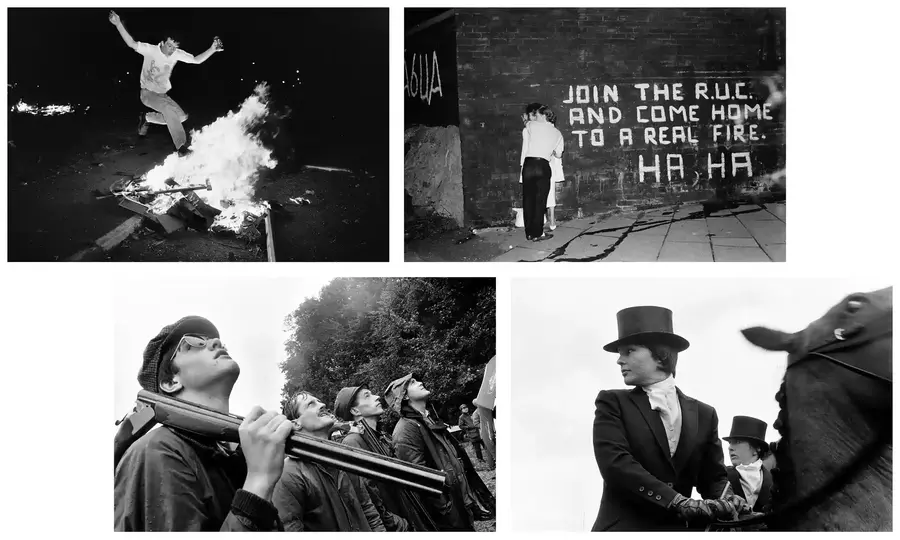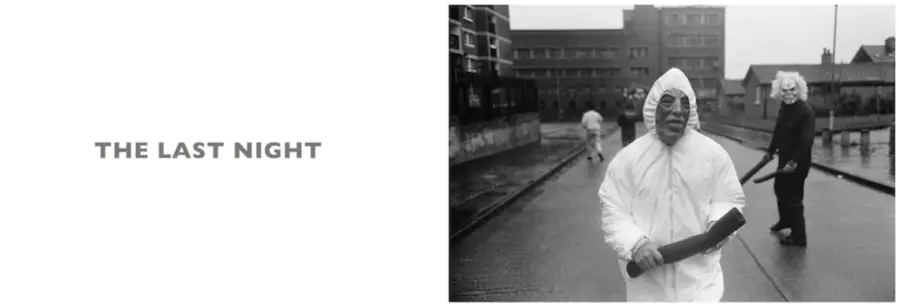Firefights, Foxhunts and Flower Shows
Irish writer Sean O'Hagan reflects on Peress' depiction of the Troubles for The Guardian.
Full ArticleWhat does it mean, in the end, to photograph cycles of Irish life, to organise them into fictional days, to print them in a book and to stand before them, on the wall, in a gallery off Oxford Street? The gesture gains meaning as a thrust in the battle for history, and to the extent it unsettles the structure of our empathy.
– Chris Klatell, from the essay 'On Whatever You Say, Say Nothing', DBPFP22 Catalogue
Peress first travelled to Northern Ireland in the 1970s, after the reintroduction of internment in 1971, and prior to and during the Bloody Sunday massacre in 1972. He returned in the 1980s with the intention of describing everything as a way of testing the limits of visual language to record and understand the intractable conflict. The resulting publication, Whatever You Say, Say Nothing, is a work of monumental achievement and complexity. Across 2000 pages, two volumes of images, and an accompanying almanac of contextual material, Peress presents a ‘documentary fiction’. A decade of photographs is organised across 22 ‘semi-fictional days’: Days of Struggle, Day of Internment, Double Cross Days, but also days where nothing happens ... boring days, days that never end. Whatever You Say, Say Nothing delineates the helicoidal structure of history, ‘where today is not only today but all the days like today’. It describes existence and experience in a space ritualised by recurring violence, while striving for the savage nature of photography that exists in the no man’s land beyond accepted forms.
Peress’ repackaging of his powerful reportage of Northern Ireland in the troubled decades of the 1970s and 1980s includes some superb darkroom prints.” – FLIP MAGAZINE
Flip Magazine
Irish writer Sean O'Hagan reflects on Peress' depiction of the Troubles for The Guardian.
Full ArticleRead Kenneth Dickerman's take on Whatever You Say, Say Nothing for The Washington Post
Full ArticleA Conversation between Gilles Peress and Gerhard Steidl, publisher of Whatever You Say, Say Nothing
Peress, who was born in France, studied philosophy and political science in Paris. Convinced of the irreconcilable gap between words and the social reality they sought to describe, he turned to photography. Here Peress discovered a mechanism, beyond language, to mediate his relationship with the world – and to describe the texture and structure of life. Questioning the efficacy of language, Peress is suspicious of attempts to construct a definitive history or to convey a stable truth. His black-and-white images circulate in a grey zone that resists categorisation and instead navigates the interstices between photography and cinema, art and photojournalism, photography and literature. It is a no man’s land, where Peress is attempting new structures and modes of transcription.
The complexity and ambition of Peress’s project is conveyed in his description of Whatever You Say, Say Nothing as a work of ‘documentary fiction’. Peress was present in Northern Ireland during the Bloody Sunday massacre and after the reintroduction of internment, and he returned many times throughout the 1980s to produce the images in the book. From the dual perspectives of the ‘Prod’ (Protestant) and of the ‘Taig’ (Catholic), Peress’s witnessing is immersive and immediate. From inside the action, Peress makes universal observations about life in zones of intractable conflict. The phrase that Peress employs is ‘helicoidal’ to describe time that is not linear, but which spirals and repeats, ‘where today is not only today but all the days like today’. And so structure is all important in this extensive work, in which a decade of photographs are organised across 22 ‘semi-fictional days’: Days of Struggle, Days of Internment, Double Cross Days. There are also days where nothing happens, Another Monday, The Morning After ... boring days, days that never end. ‘I wanted to describe Everything,’ Peress relates. He returned again and again to the same streets, in sunshine and in rain, by day and by night. He employed multiple camera angles and visual strategies in an attempt to capture an impossible totality. Whatever You Say, Say Nothing describes all that defines existence and experience in a space ritualised by recurring violence; it is about memory and history and simultaneity. Life goes on, on different sides of the conflict, and as catastrophe unfolds.
Peress is Professor of Human Rights and Photography at Bard College, New York and Senior Research Fellow at the Human Rights Center, UC Berkeley. His earliest projects focused on immigration in Europe, and he has since documented events in Ireland, Lebanon, Palestine, Iran, the Balkans, Rwanda, the United States, Afghanistan and Iraq. Peress has exhibited at the Museum of Modern Art and PS1, New York, the Pompidou, Paris, the Art Institute of Chicago, and the Corcoran Gallery of Art, Washington DC. His photobooks include Haines (2004); A Village Destroyed (2002); The Graves: Srebrenica and Vukovar (1998); The Silence: Rwanda (1995); Farewell to Bosnia (1994) and Telex Iran (1984/1997). Awards and fellowships Peress has received include: The Guggenheim Fellowship, Pollock-Krasner and New York State Council of the Arts fellowships, the W. Eugene Smith Grant for Humanistic Photography and the International Center of Photography Infinity Award.

